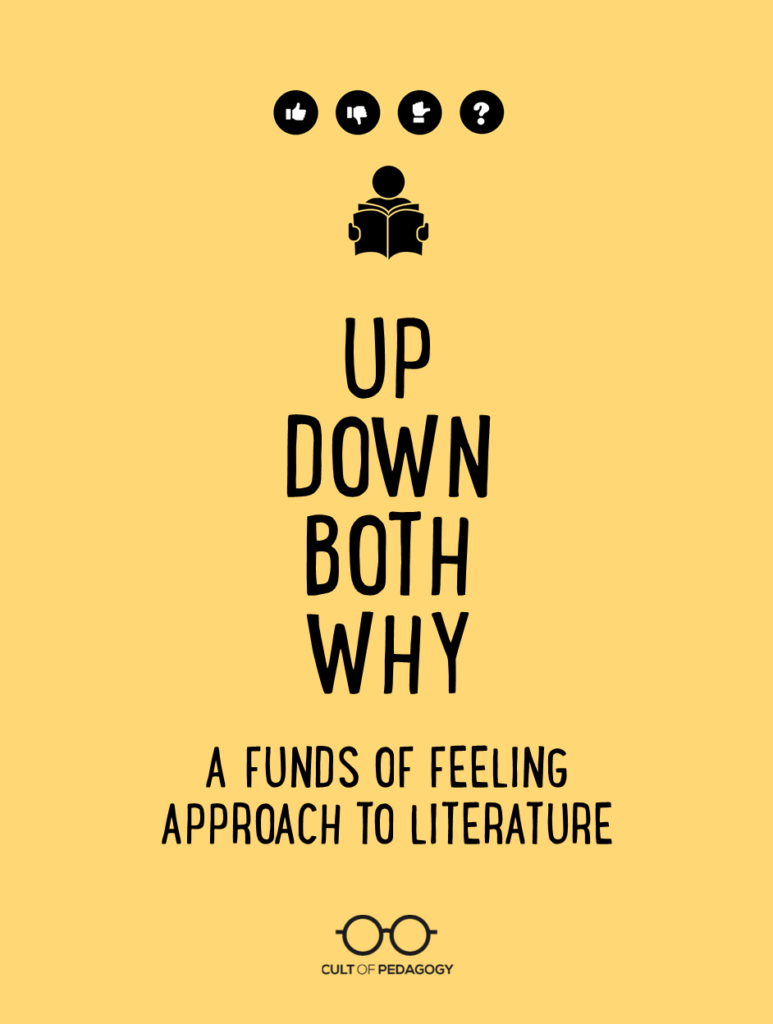
Listen to the interview with Sarah Levine:
Sponsored by Kialo Edu and National Geographic Education
Literature makes readers feel things. In your everyday reading life, you might hate a certain character, feel disgusted by violent imagery, cry at the end of a book, or be outraged or frustrated by an author’s racism or sexism. Unfortunately, our current teaching climate often doesn’t make a lot of room for feeling in literary reading. Standardized exams, for example, generally ask students about symbols and central ideas, but do not ask students to consider their own emotional responses. As a result, students often perceive literary reading as an exercise in summarizing or focusing on surface-level meaning.
But in their everyday, out-of-school lives, students can be passionate interpreters of all sorts of literary texts, from stories and poems to movies and songs. In the early 1990s, Norma Gonzalez, Luis Moll, and other scholars coined the term funds of knowledge to describe knowledge that people developed out of school, as part of their everyday lives and cultures—knowledge that was just as valuable as in-school knowledge. Gonzalez and Moll urged educators to draw on students’ funds of knowledge, thus connecting in- and out-of school learning.
Just like students have funds of knowledge, they have everyday funds of feeling that are integral to literary reading, and that teachers can draw on to help connect in- and out-of-school reading and feeling-based responses. The strategy described here—Up-Down-Both-Why—puts students’ everyday funds of feeling front and center in the process of literary interpretation. Up-Down-Both-Why is designed to help bring the heart back to literary reading and move students from conventional summary and literal sense-making to rich, thoughtful interpretation. Readers draw on their initial feelings—in particular, negative and positive responses to texts—and use them as a jumping-off point for interpretive reading. When students use this approach, they are more likely to build connotations and symbolic meaning, evaluate characters, and reflect on big ideas about how the world is or how it should be (Eva-Wood, 2004; Levine & Horton, 2013; Levine, 2014) .
What is Up-Down-Both-Why?
The strategy works like this: First, read with an eye toward text that seems especially positive, negative, or both. Then, ask yourself why it seems that way.
When teachers introduce this approach, they often ask students to imagine a continuum with positive on one side, negative on the other, and combinations in the middle:
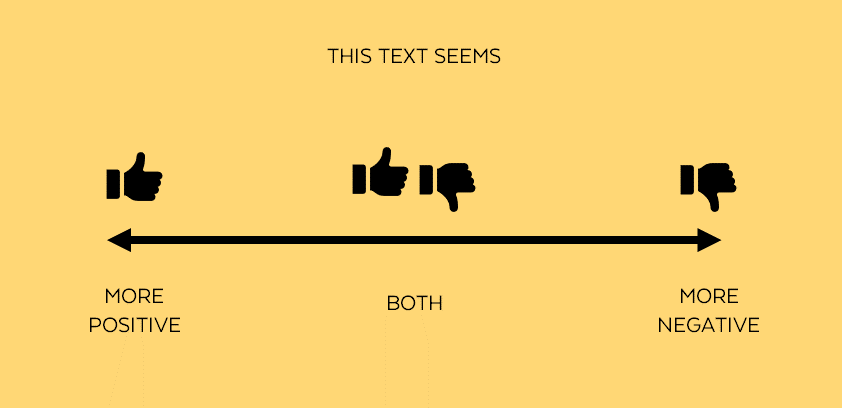
Formally, this strategy is called affective evaluation, but teachers and students have come to call it “up-down-both-why” because in practice, people often draw up and down arrows or make “thumbs up” and “thumbs down” gestures to communicate their evaluations. They also sometimes use the words “up” and “down” as shorthand for “positive” and “negative.” Hence, “up-down-both-why,” or UDBW.
Whose UDBW? Mine? The Author’s? Both?
When using UDBW, you might make a “personal reading,” focusing on your own positive and negative responses to a text, drawn from your understanding of your world. You might also make what is called an “authorial reading” (Rabinowitz & Smith, 2005), focusing on your sense of the positive and negative responses an author might expect you to feel as you engage with the world the author has created. Most of the time, your reading comes from both places.
For example, let’s say you see this limo on the street.

In this case, you’re the reader of this “text,” and the authors of this text are the people who rented this car for the day and are showing it to you.
As a reader, your personal response to this text might be more positive. Why? Maybe you associate such a limo with fun, wealth, high status, or luxury. Or your personal response might be more negative. Why? Maybe you’re thinking about self-indulgence, or elitism.
However, you probably understand that the author expects you to see this “text” as more positive. Regardless of your personal associations, you can infer that the author of this text is probably using the limo to create a positive sense of status, luxury, and value.
The closer you are to the author’s world and its norms and expectations, the closer your personal and authorial UDBW are likely to be.

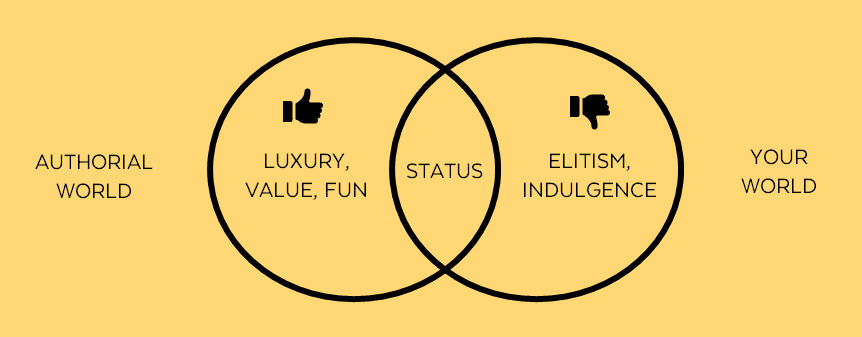
Either way, you consistently want to ask your kids to consider both kinds of readings. You can teach them to ask themselves, “How do I personally feel? and How do I think the author might expect me to feel?”
What does UDBW look like in action?
Readers’ interpretations work on many literary dimensions, from a single word in a poem to a critical reading of a music video (Lee, Goldman, Levine, & Magliano, 2016). Some of the most common dimensions include:
- Connotations of words, images, names, objects
- Judgments about characters
- Overall thematic inferences
- Aesthetic evaluations (reflections on the beauty or effectiveness of authorial craft or literary devices)
- Critical lenses (examinations of the way race, gender, power, and other aspects of identity and society are portrayed)
Readers can make use of UDBW at each of these dimensions too. They can use a simple positive-negative scale, or adapt the language in their scales to better fit different literary dimensions:
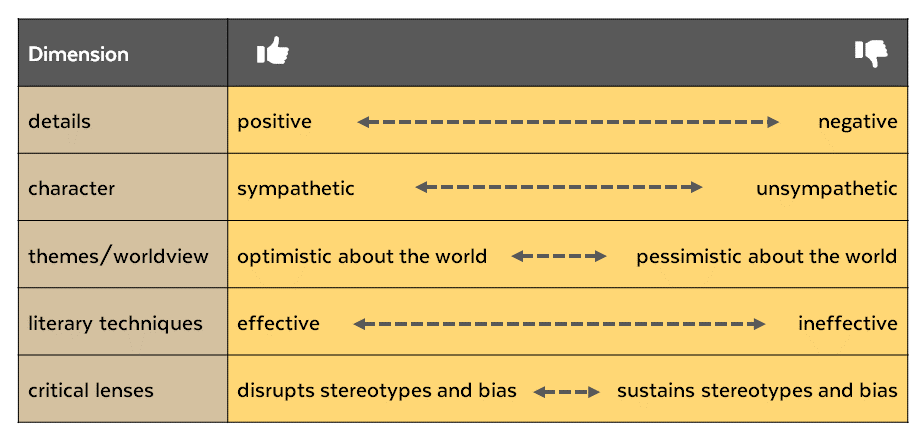
Below are examples of high school sophomores and juniors using UDBW at each of these dimensions. These examples all come from classrooms where students were reading “Linoleum Roses,” one of the vignettes from Cisneros’ The House on Mango Street (below).
Dimension 1: Focus on Details
Here’s an example of one student doing a close reading of this vignette. The student was using UDBW as she read, meaning she was reading with an eye toward text that she found to be especially positive, negative, or both. She paused first at the detail, marshmallow salesman, and then described her positive and negative associations with that phrase.
To me, marshmallows are positive because they are sweet, but also negative because I don’t know, it’s like there’s nothing to them, and like to be a marshmallow salesman? First of all, no one sells marshmallows, like door-to-door or whatever. So it’s like this guy is selling nothing, so that seems negative, like he’s just shallow.
Because the phrase marshmallow salesman is a bit unusual, it is likely to communicate or elicit a stronger response than some other words in the sentence. Using UDBW helped this student to “bump” against this phrase, and then move on to describe her positive and negative associations. By asking herself why she felt both positive and negative responses, she was able to move from the concrete (marshmallow salesman) to the abstract connotation or symbolic meaning (“this guy is selling nothing, so that seems negative…shallow”).
Often, kids can identify interesting language but don’t know what to do with it. They might say, “This is a good image,” or “Marshmallow salesman is weird.” UDBW —connecting text to negative and positive associations—seems to help kids move from literal to interpretive sense-making.
Dimension 2: Focus on Character Interpretation
Students are probably most comfortable thinking in positive and negative terms when talking about character, since they do the same when thinking about the people in their own lives. One useful scale to support students’ interpretations of character is anchored by “sympathetic” at one end and “unsympathetic” at the other.
Here’s an example from a discussion of “Linoleum Roses,” in which the teacher asked students whether, overall, they found Sally to be more sympathetic, more unsympathetic, or both. Most students put their thumbs both up and down, and explained their evaluations as follows:
Student 1: She don’t know what love is. She don’t know what she’s getting into!
Student 2: Innocent.
Student 3: Unaware.
Student 4: She doesn’t have much education.
Teacher: And does that make her seem more or less sympathetic to you?
Student 4: More, because she might be taken advantage of.
Student 5: But she should know enough to not stay with him. She’s old enough to not act stupid.
Student 2: No, she’s vulnerable.
Students can also use simple sentence stems to talk or write about characterizations:
The text characterizes Sally as both sympathetic and unsympathetic by showing her to have not a lot of education, but at the same time being ignorant to how the husband is abusing her.
Dimension 3: Focus on Thematic Interpretation
UDBW can be especially helpful when students are building thematic interpretations. Even though we want our students to see subtlety and nuance in texts, they often end up thinking about themes in terms of simple morals or lessons. A way to address this problem is to ask students to think about themes in terms of worldviews: the author’s (or the text’s) attitudes and perspectives about life and human interactions.
In these terms, texts are worlds filled with people and things: marshmallow salesmen, broken screen doors, smooth ceilings, women sitting alone. And worldviews are an author’s (or text’s, if you don’t want to talk about authors) attitudes and perspectives about those worlds.
Using UDBW, students can think about themes/worldviews on a continuum anchored by optimism at one end and pessimism at the other at the other. This continuum can work in general or specific terms. For example, to what degree do you think The House on Mango Street (or author Cisneros, if you prefer) is optimistic or pessimistic about humanity in general? Or more specifically, does the novel seem more optimistic, more pessimistic, or both, when it comes to the role of women in society, race, immigration, or belonging? And why do you say so?
Note that when asking your kids to talk about themes or worldviews, it’s helpful to have them focus on last lines, final chapters, or overall effects. Readers can really only fully reflect on textual or personal worldviews after they have finished a text, and have seen the entire world that a text has to offer. Then, as readers consider the text’s worldviews, they can also reflect on the degree to which those worldviews align with their own.
Below is an example of another activity involving “Linoleum Roses.” Kids talked in small groups about whether the text overall seemed more “up,” “down,” or both (that is, optimistic, pessimistic, or both) about love and relationships, and explained why. Then each student wrote about their specific interpretations, and decided where each interpretation belonged on an optimistic/pessimistic continuum.
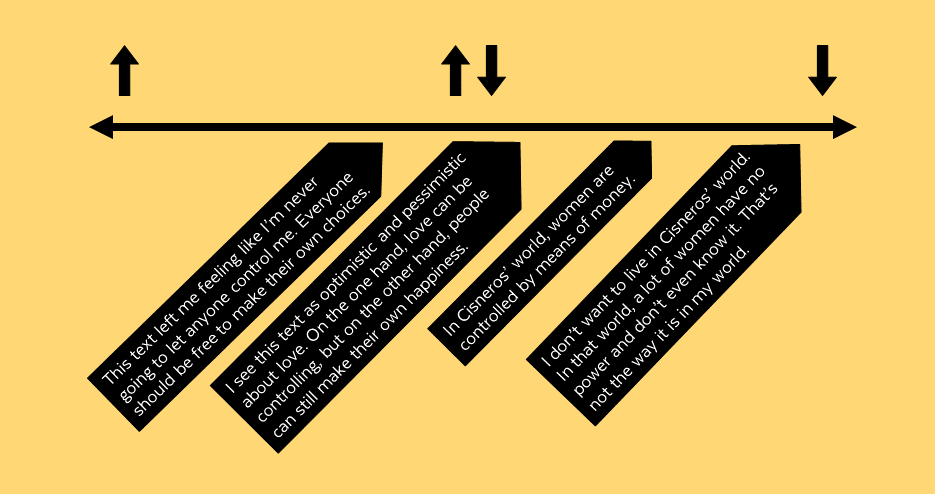
Notice that some students used sentence stems to jumpstart their interpretations as well, including “In the author’s world…” or “I see this text as [more positive, more negative, or both]… .” You can offer sentence stems using more or less academic language, have students create sentence stems themselves, show a range of examples as possible models—whatever works best for you.
Dimension 4: Focus on Literary Techniques
In the classroom, students are often good at identifying literary techniques, as in “that’s a motif,” or “there is alliteration in line 5.” However, they often get confused about what to make of those techniques after identifying them. They might say, “that image really helps you imagine what’s going on,” or “that’s a good metaphor.” In a classroom context, talking about effects of particular techniques is intimidating. Students may be afraid they will give the “wrong” answer, and stay silent. Or they may feel the whole enterprise is for show. As one student put it, “English is about reading poems and telling about rhythm… It’s about NOTHING!” (Smith & Wilhelm, 2002, p. 25).
Reflecting on emotional responses gives students a framework on which to build interpretations of authorial techniques in several ways.
Moving from Techniques to UDBW
First, you can use UDBW to help students move beyond identification of authorial techniques. Let’s say you are asking students to identify patterns in the paragraph below. Students are good pattern seekers, so they might notice that the words “except” and “and he doesn’t” repeat several times.
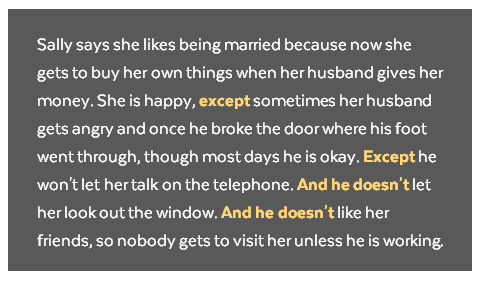
The trick now is…so what? What work might these repetitions do? Students can now use UDBW to ask themselves: “Do these patterns create more positive effects? More negative effects? Why?” Most will likely conclude that the patterns create negative effects. Why is that? What associations do you make here? In previous class discussions that I have heard, students have named concepts like limits, control, meanness, power, abuse, and lack of self-knowledge.
Moving from UDBW to Techniques
A second way of using UDBW to consider authorial techniques is to begin with emotional responses and use them as a guide to noticing such techniques. Here’s an example of one student’s annotations of a paragraph from “Linoleum Roses.” The arrows represent places where the student identified more positive and negative effects (the “ups” and “downs” of UDBW) concerning mostly imagery and character. The text boxes alongside the passage are where the student explained those evaluations (the “whys” of UDBW).
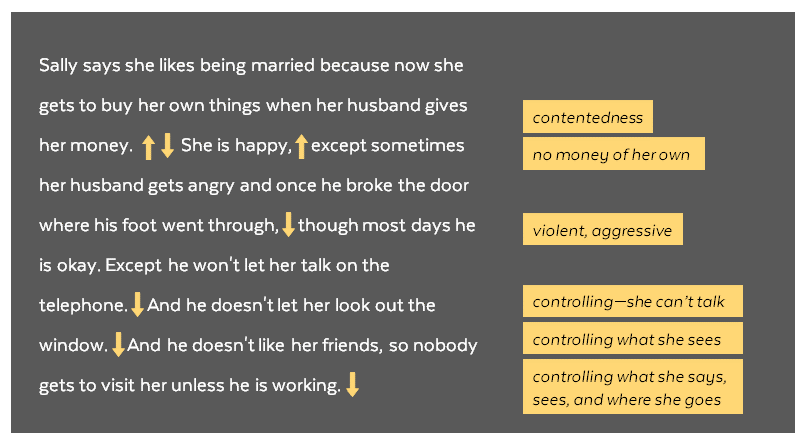
The student then moved to thinking about patterns. Instead of looking for patterns in the author’s language, the student looked at patterns in her own arrows and annotations (their ups, downs, and whys). The student saw that most of her “down” arrows connected to ideas about power and control. In discussing patterns, the student said, “It actually starts out okay—maybe she’s happy. She thinks she is happy. But then it gets more and more negative. I ended up annotating the whole thing as ‘down.’ The pattern I see is control.”
UDBW for Aesthetic Impact
You can also think about literary devices or other authorial moves in terms of their aesthetic impact or efficacy. In the real world, critics talk about whether authorial moves “worked” or were “effective.” Kids make these kinds of critiques as well, but generally do so only when they are familiar with the genre they are discussing; for example, a kid can easily critique a TV love scene as cheesy or appreciate a song lyric as original.
It’s more difficult for students to make these kinds of critiques with novels, short stories, or the kind of poetry they often read in school, because they may not have enough experience with those genres to know if a writer is doing something original or exciting. But you can use UDBW as a way into those discussions by asking them to consider an author’s craft on a continuum anchored by “effective” on one end and “ineffective” on the other, or “more powerful” on one end and “less powerful” on the other. Or students can define their own scale.
For example, with “Linoleum Roses,” you might ask students to discuss which of the three paragraphs they think is most effective in painting a picture of the main character, or whether there’s a line they think the author could get rid of without diminishing the impact of the story. Using Cisneros’ entire novella as a larger example, you might ask students to decide which vignettes they think are most powerful, or best written, or what metaphors they found to be most positive or negative, and why. While making such comparisons can feel artificial or reductive, doing so helps students develop criteria for effective artistry on their terms, but while being responsive to the text.
Dimension 5: Critical Lenses
By the time they reach middle school, and often much earlier, students are already skilled at looking at the world through a set of critical lenses—considering who gets to speak and who is silenced, what might be racist or anti-racist, how society has different expectations for different genders, and so on.
UDBW lends itself well to the application of critical lenses, and is probably one of the easiest and most satisfying ways to use UDBW. You decide the scale and the dimension based on your and your students’ interests and unanswered questions. For example, in “Linoleum Roses,” you could focus on the character level: Sally’s husband is definitely not a feminist. What about Sally? To what degree would you say Sally is a feminist? Or you could bump up to the authorial level: To what degree is Cisneros portraying Sally as a stereotype? To what degree does House on Mango Street use or defy stereotypes?
Fine-Tuning and Troubleshooting
What if students aren’t sure how to communicate their interpretations?
Many teachers use sentence stems to support their students as they work to communicate their ideas, especially in academic contexts. For example, when talking about details, students might use stems such as:
This image creates a sense of…
The language creates the feeling that…
Here are two sentences that students wrote using such stems:
The image of the marshmallow salesman creates a sense of emptiness and nothingness.
The language creates the feeling that the marshmallow salesman is not actually selling anything, because marshmallows are sweet, but there is nothing to them.
What if students focus only on personal readings and do not consider authorial readings?
Sometimes a student will focus only on their personal emotional reading without considering potential authorial readings. Or maybe they make an authorial reading that you feel is not supported by the text. This happens for all sorts of reasons—sometimes a student doesn’t understand what is going on literally; sometimes they are missing an author’s ironic tone; sometimes they don’t understand the terms of the fictional world; sometimes they are taking the perspective of just one character; sometimes they’re not paying attention to context. Sometimes they just don’t agree.
For example, maybe a student finishes reading “Linoleum Roses” and says, “I see this as completely ‘up.’ Sally is happy, so that’s good, and her house reminds her of wedding cake, which is positive. And I think the author’s attitude is optimistic.” This is often a tricky area for teachers. We don’t want to devalue the student’s response, but we think the student is missing some major negative effects of the text.
There are some things you can do to help students understand possible distinctions between personal and authorial readings without devaluing their initial personal responses. First, you don’t have to argue with students about their initial personal reactions. A benefit of UDBW is that students are the experts in their own emotional responses. But you can consistently ask them to consider their personal emotional responses alongside the emotions they think the author might have expected audiences to feel.
To do this, you can return to simpler texts, like the picture of the limo at the top of this post, and remind students that there can be differences in authorial and personal readings. You can work through examples that illuminate potential differences. For example, in my personal reading of Harper Lee’s To Kill A Mockingbird, I find Atticus to be kind of “down,” or unsympathetic; he embodies the white savior trope, and won’t let Scout use the “n word”– not because it’s evil, but because it’s “common.” However, in the world Harper Lee has created, my sense is that Atticus is meant to be very “up,” or sympathetic; Scout loves him, he can shoot straight, and he looks like a hero in the courtroom. So in this case I see that my personal emotional response to the character is likely different than the response the author might have expected me to have.
Another way to help students consider different readings is simply to ask other students to chime in—did they make the same “up” reading? Why or why not? Often, other students do the job of helping their classmates see things they missed. You can ask students to share their UDBW responses to a detail, character, or whole text by putting their thumbs in the air. Then you can all just look around the room and see the range of different responses.
Also—and sometimes teachers struggle with this—you can disagree with the student yourself. You are a member of the classroom community, and you are allowed to share your personal or authorial interpretations. You might say, “Oh, wow. I went the other way. I felt so sad after reading this. And I feel like the author is pushing for a much more pessimistic effect about marriage or love.” You can point to details that led you to your readings: “All those details about the husband made me feel really sympathetic for Sally. How do you deal with those details in your reading?” Your student may push back (“Sally doesn’t care; it says so right here, So why should we?”) or they may not.
Or you can let it go and see what happens. Most important is that students know that they can use their own positive and negative responses as a jumping off point to build interpretations; that their own personal attitudes may not be the same as authorial attitudes; and that they learn ways to consider both.
What if students focus only on the binary and ignore nuance?
If students focus only on extremes–positive or negative–then using UDBW can be reductive. The key here is to offer a continuum—more positive, more negative, or both. My research shows that students consistently offer nuanced interpretations of texts, even though they are beginning from a simple place. You can also help students experience nuance by having them create a continuum of descriptors for positive and negative, sympathetic and unsympathetic, optimistic and pessimistic, and mark where their response lies on that continuum.
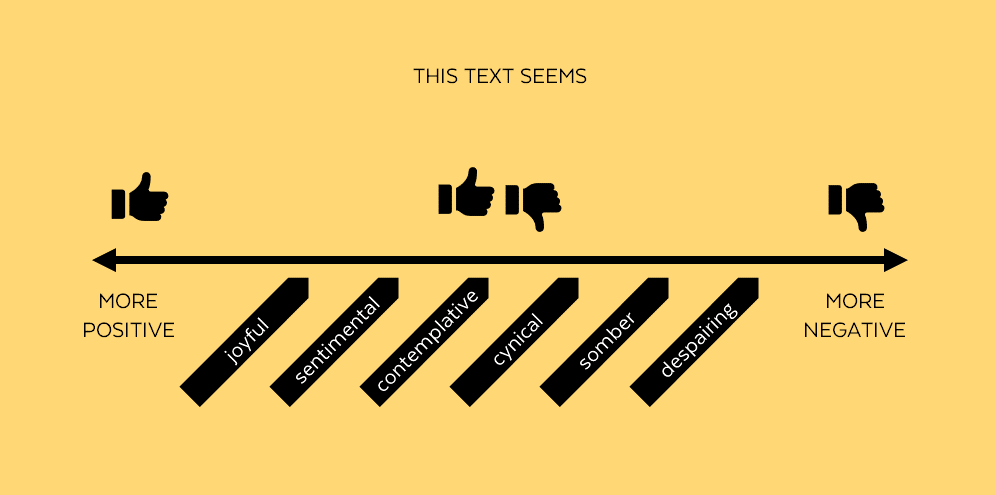
Sometimes a student focuses only on one line that is particularly positive or negative, and forgets about the rest of the text. In that case, you can ask the student to take a look at all the up/down/both arrows they used to annotate a text when they read it. Those annotations can be a helpful visual tool to guide students’ interpretations and to remind them of the nuance in a text.
Drawing on funds of feeling can support students’ literary reading. Hopefully, an approach like UDBW will help your students connect with literary texts and build interpretations that lead to richer reading experiences. Beyond that, reading with feeling is a way into empathy, which lies at the heart of our hopes for our kids.
Special thanks to the English Language Arts teachers at Curie High School in Chicago for helping to develop this idea.
References
Eva-Wood, A. (2004). How think-and-feel aloud instruction influences poetry readers. Discourse Processes, 38, 173–192. doi:10.1207/s15326950dp3802_2
Lee, C. D., Goldman, S. R., Levine, S., & Magliano, J. (2016). Epistemic cognition in literary reasoning. Handbook of epistemic cognition, 165-183.
Levine, S. (2014). Making interpretation visible with an affect-based strategy. Reading Research Quarterly, 49, 283–303. doi:10.1002/rrq.2014.49.issue-3
Levine, S., & Horton, W. S. (2015). Helping high school students read like experts: Affective evaluation, salience, and literary interpretation. Cognition and Instruction, 33(2), 125–153. doi:10.1080/07370008.2015.1029609
Rabinowitz, P.J., & Smith, M.W. (1998). Authorizing readers: Resistance and respect in the teaching of literature. New York, NY: Teachers College Press.
Smith, M., & Wilhelm, J.D. (2002). Reading don’t fix no Chevys: Literacy in the lives of young men. Portsmouth, NH: Heinemann.
Join our mailing list and get weekly tips, tools, and inspiration that will make your teaching more effective and fun. You’ll get access to our members-only library of free downloads, including 20 Ways to Cut Your Grading Time in Half, the e-booklet that has helped thousands of teachers save time on grading. Over 50,000 teachers have already joined—come on in.

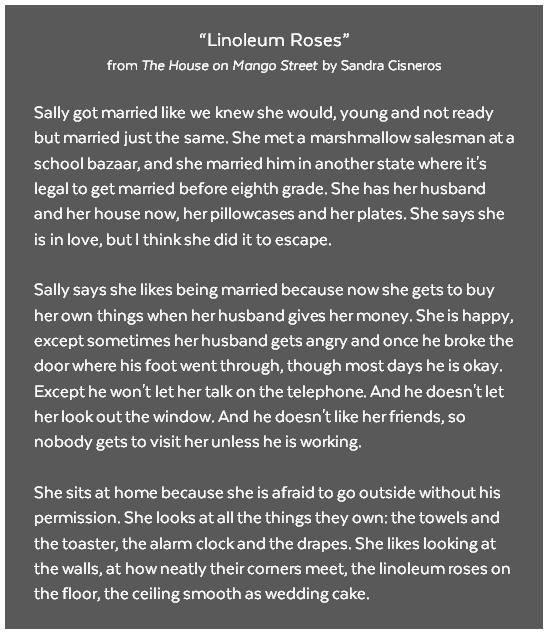




Love this! We are always looking at ways to help our grade fours make their thinking visible. We have used many of the routines from Making Thinking Visible, and this will fits so well into that model. As we begin a new read aloud, we are hoping to use the “UDBW” to help our students interpret the story. Thank you.
That’s great. Please email me if you have questions or ideas.
Hello,
I am a 10th grade English teacher currently reading Fahrenheit 451. My brain is abuzz with ways to incorporate this with tomorrow’s reading of part II. Any ideas you may have would be greatly appreciated. I think I’ll start with the line graph. I think my students can grasp that. Thank you for the inspiration!
Hi Melissa – I love that you’re trying out this approach. I’m not sure what your overarching goals are for reading the novel – exploration of language, of freedom of thought, etc… but here are some possible UDBW activities that might get at some of those goals:
One possibility as you head into part 2 is to use the line graph to rank the characters, so far, in terms of really unsympathetic (you want them to fail, you find them immoral) on one end and really sympathetic (you’re rooting for them, you identify with them, they seem to be on the side of good) on the other. At this point, kids might perceive Montag to be more sympathetic or unsympathetic, or both. They can argue /debate/discuss where they think he belongs on that line. The important thing with this discussion, of course, is to push them to explain why they have placed MOntag where they placed him (or any other character). You can preface an activity like this with something like “I [or other readers or critics] cannot decide what I think of Montag at this point. I feel kind of sorry for him, but he’s also kind of a horrible human being — where do you all stand?”
Another possibility is for you to pull out a few ambiguous quotes from Part 1 that you could use to have kids debate whether MOntag is more or less sympathetic based on these excerpts.
Another possibility is to have them predict whether this story will ultimately end on an optimistic note or pessimistic note, and why they think so. This is more about how they see the author as setting them up one way or another. You can preface such a discussion by saying that “some people say that Bradbury is setting us up for tragedy here, and some say he’s setting us up for a happy ending. What do you think, and why?”
Another way to go is to take a look at the different language Bradbury uses when describing fire and water – – you can look at a bunch of excerpts (or have the kids find them) and UDBW each description – this helps kids get a sense of how Bradbury manages to create the atmosphere that he does.
I’m sure you’ve got great stuff planned. THANK YOU for being a teacher.
Sadly, my students seem to have little interest in reading so Ive been searching for ways to change this. I found this article enlightening in its simplicity. Students can read with their hearts. Humans are emotional beings; asking students to respond with positive or negative feelings/associations is a natural way for them to react and should be less intimidating than traditional ways of understanding a text. I’m looking forward to applying some of the author’s ideas. I will be delighted if I can use reading to guide students toward more empathy (which, in my opinion, is much more valuable than a high test score).
Hey Kim,
I’m so glad you enjoyed the article – I’m just sorry to hear about the kids. One of the things that I think is so important to do is read aloud to your students every single day. If something has to give, let it be something else. If you teach HS students, share an article or a quote from a book – anything that helps them spark curiosity, start a conversation, and see reading as relevant. Also consider the things you’re asking kids to do. This is one of many posts that we have tagged in our English Language Arts category. If you haven’t already, go take a look. Hope this helps!
I am in LOVE with this!! I can’t help but believe that embedding emotional intelligence into reading instruction is another (often overlooked) essential part of what it means to be a good reader. In a world where we all — teachers and students — are simultaneously bombarded with media, texts, etc. aimed at our hearts AND told to “control your feelings” it’s harder than ever for readers, or humans for that matter, to take a moment to pause in those emotions before reacting. This habit of mind does just that. Thank you!!
So glad you enjoyed the post Jaime!
Hi everyone!
I just wanted to say thanks for this practical, actionable episode! I love The Cult of Pedagogy and I usually learn a lot in terms of theory and get some much-needed inspiration. This episode is so practical that I read the article and listened to the episode. I used this approach in my class yesterday; we read a poem and I asked them to up-down-both first, then asked for some whys and the discussion was richer than usual! Sending my gratitude from Montreal, Quebec.
That is fantastic. I’m glad it was helpful. Tout le meilleur !
Why, I’m gonna try this with the smalls.
I’ll be curious to hear how it works. Keep me posted.
This is a game-changer for me – it will help my language learners see the layers in a text, help those middle school students struggling to ‘get’ poetry, and help students see the voice of a character in their empathic writing. Our focus this year is on Tone and building a Tone vocabulary – this is a PERFECT fit! Thank you for always finding the best ‘stuff’!
Fantastic! I’m so glad this is helpful.
I teach 5th grade and would love some ideas on how to use this with elementary students, particulary ESL learners.
Hi Karen:
Thanks for writing. Here are some suggestions for using UDBW with elementary students (like 4th or 5th grade–I actually am not sure how it might work with students younger than that. You would know better than I would) who are already fluent in one language (or more!) and are also learning English.
First, try starting UDBW at the level of detail or characters. I think those two levels are more accessible for younger kids.
With details like single words or phrases: You can ask students to consider the associations of synonyms for a word. Having them compare words that have kind of similar denotations helps them to see that they attach feelings and associations to different words to build connotations. You can ask them to create a scale like this, either just in English or in their first language as well (I’m using Spanish as an example)
positive./positivo………………………………………..negative /negativo
or something with more specific feelings might be easier, like
happy/feliz………………………………………….unhappy/infeliz
Let’s say you ask them to consider the associations of different words for move, like:
Then ask them all the words they can think of that mean “move forward,” like walk…or saunter, stroll, march, trudge, wander, race, sprint (you can supply some too). They can teach each other what they mean, with those who speak different languages teaching others their words. (As you know, google translate helps too, if you can handle the pronunciations.)
andar, vagar, and so on
Then start with two words that seem pretty dissimilar, like march and stroll, and ask which where kids would put them on the scale. Which seems more positive? If some kids don’t know the words, you can get a kid or two to demonstrate, or you can do so – you get the idea.
negative —positive
happy —unhappy
Kids will have different ideas where the words fall, depending on how they contextualize them. If you’re marching to war, that seems negative. If you’re strolling through the market, that could be good. You push them toward the “why” to help them see ways that different words can offer really different feelings. You don’t have to worry about the fact that context is everything for right now. The larger point is that we attach feelings to words.
kids might disagree a bit – that’s good – it pushes them toward talking about associations.
Another example: each of the following things is a house/casa:
mansión, shack, cottage, cabaña, .
you can ask students to put them on a scale like:
positive…negative
or something even more specific might be easier, like
more powerful…less powerful
happy…unhappy
Then ask them where they think each word belongs, and why. If someone says that mansion (or mansión, in spanish) seems like a more happy word, you ask why. Maybe they say, because rich people live there, and then you help them see that rich is an “association” or big word “connotation” of mansion. OR maybe they say it’s more of an unhappy or negative word, because rich people live there and rich people suck . You ask why – they say because rich people are mean , or greedy, or something. So then you say “ah, so the association you have with mansion is greed.” and so on. Then they are learning about connotation and association, which you can then use in a billion other contexts.
For character: You could use the small detail /synonym exercise for when you are, let’s say, writing a story about a particular character. You want the character to be a villain. To make him a villain, where should you have him live? should the character live in a…mansion, shack, cottage, etc.? Then you’re working on ways that details can help build character.
SImilarly, as you’re reading about a character in a story, you can stop on a particular verb that you think does a good job of characterization or communicating mood, and you can ask: :”What if instead of him running up the hill, the author had written that he ‘strolled up the hill’? Would that make the character seem better? worse? both? why? ”
I hope that some of these ideas are helpful, or maybe at least get you started coming up with better stuff that works for your particular kids.
Good luck!
Thanks for this practical and direct method! I’m going to give it a try this week with some of my freshman critical reading students.
Wonderful.
I am using this tomorrow! I love the challenge of adapting ideas to fit my audience of 3rd graders, many of whom are ELLs. The kids love being asked their feelings and it makes literature more personal. Thanks!!!!
I listened to the podcast and could hardly wait to get home and look this up. I’m going to try it in class tomorrow with To Kill a Mockingbird.
When asking if a character is more sympathetic or unsympathetic are you talking about how we, the reader, feel towards that character, or how the character feels? Or both? Thank you for introducing me to this concept.
Hi Tracy – I think I missed this email earlier – my apologies. You can use UDBW to talk about 1) whether you think a character feels more positive or more negative about something; 2) whether you feel more sympathetic or unsympathetic toward a character, and why; or 3)whether you think the author/text is attempting to portray the character more sympathetically or unsympathetically . #2 and #3 work together – so for example, I think Harper Lee wants me to feel sympathetic toward Atticus (wants me to root for him and see him as a positive force) based on her portrayal of him as a thoughtful dad, and based on the way she has other characters respond to him with such respect, esp. the Black audience in the courtroom. and so on. BUT even though I am pretty sure she’s expecting me to feel sympathetic toward him, I don’t feel so sympathetic. Looking at him through my own personal set of critical lenses and my current understanding of the world, I find him to be a little too much of the “white savior” figure. So Harper Lee is aiming way “up” with her portrayal, but my personal response is not as “up.”
I’m so head over heels for UDBW and my students are responding so well to this strategy. How can I incorporate into non fiction texts?
Hi Anita – I’m so glad UDBW is helpful.
UDBW works well as an interpretive strategy with non-fiction texts that are rhetorically powerful – so political speech, tweets, ads. For example, if you’re looking at “Letter to A Birmingham Jail,” kids can be reading with an eye toward especially positive and/or negative language. Reading this way often leads them to notice repetition, juxtaposition, metaphor, and so on. Then they can talk about whether words/sentences/even structure seems more positive or negative or both, and why. If you’re using critical lenses, you can also use UDBW to look at things like textbooks (what’s the connotation of “slave” vs. “enslaved people” or “immigrant” v. “colonizer”? )
However, UDBW is not useful with informational texts (how to make peanut butter sandwich, bus schedule) UNLESS, again, you are reading with critical lenses in mind – so let’s say a wikipedia entry where you’re looking to see if the language seems racially biased or potentially sexist.
Let me know if that answers your question. Thank you!
I am a teacher from Germany, taching students at a socondary school, and just listened to this great podcast episode that motivated me to “try again”. I find it very hard at times to make my students become more related to literature and reading books in general. This is a new apporach that might be very helpful for my lessons and insoiring them to talkwith me and actually discuss a story. I am so glad that I listened to this podcast. THANK YOU!!
Maybe I should translate your idea and concept into German….
I adore this approach, especially for helping students to look at a text critically and creatively.
(I can’t wait to try out this more nuanced approach with my middle and high school students.)
Thanks for posting this amazing article! 🙂
Glad you enjoyed the post, Ruth!
I would LOVE to see if anyone has incorporated this strategy with another one of my favorites I learned about here, “TQE.” Has anyone had success in melding the two? I am struggling because to me, TQE is also a way of analyzing and responding to text: author’s intention, details, word choice etc. I can’t determine if using both for one text is redundant or if they would mesh well.
Hi Jennifer –
This is a good question. I think UDBW works to help readers make sense of something they are reading (“What is up with the husband being a marshmallow salesman” can become “Does ‘marshmallow salesman’ seem more positive, more negative, or both? Why?”
UDBW also works as a guide for teachers when they are asking questions (so instead of “What is the deeper meaning?” or “What is the theme?” teachers can ask “Does this text seem more hopeful or hopeless, or both, and why?”)
With those two things in mind, I could see UDBW working with the “thoughts” part of TQE . If students already knew how to use UDBW, then they could use it while reading and jotting down their thoughts about a text (e.g. “The last paragraph seemed really negative to me” or “I thought this character was unsympathetic”).
I don’t think it would make as much sense to use UDBW in the questions part of TQE, because UDBW is more designed to help readers explore questions. The questions that arise for readers as they read might occasionally draw on UDBW, as in “Is this character supposed to be likable?” or “I can’t tell whether this text ends more optimistically or pessimistically.”
But for the most part, if UDBW is more of a sense-making tool, it seems like it would fit best with the “thoughts” aspect of TQE.
hope that’s helpful!